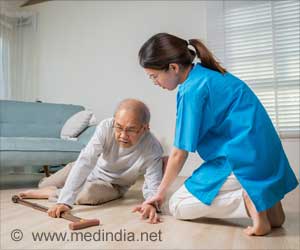In elderly, applying imperceptible vibratory stimulation to the soles of the feet improved balance by reducing postural sway and gait variability, reveals new study.

• 1 in 3 seniors falls each year, and 25% of those who fall suffer moderate to severe injuries, such as hip fractures.
• Only 25% of hip fracture patients make a full recovery; 40% require nursing home care; and nearly 25% die within 12 months.
• By 2020, the annual direct and indirect cost of fall injuries is expected to reach nearly $55 billion.
"Although loss of sensation in the feet is a common problem among elderly people that can impair balance and gait and result in falls, there are currently no interventions available that can reverse sensory impairments and prevent these dangerous consequences," said study lead author Lewis Lipsitz, M.D., Director of the Institute for Aging Research. "We were very excited to discover that small amounts of vibratory noise applied to the soles of the feet may be able to do just that."
This study follows earlier research that looked at how the physical principle of stochastic resonance could be applied to mitigate deficits in the human somatosensory systems that develop due to disease, injury, or age. The somatosensory system informs us about objects in our external environment through touch. Receptors are distributed all over the body and different types of receptors respond to many different kinds of stimuli. Stochastic resonance (SR) is a phenomenon whereby the detectability of weak signals in certain types of systems can be improved through the careful addition of low-amplitude white noise. This may seem paradoxical because noise is usually thought to reduce our ability to detect a signal, for example, we may have difficulty hearing someone talking to us at a noisy party, but the principle of SR states in fact that a certain low level of white noise can actually enhance signal detection.
Earlier studies, by Wyss Institute Core Faculty member James Collins, Ph.D., a Professor of Medicine and Biomedical Engineering at Boston University, have shown that imperceptible vibratory noise applied to the feet can improve balance in healthy young and elderly subjects and patients with diabetic neuropathy and stroke. IFAR researchers showed that this approach could significantly reduce the stride-, stance- and swing-time variability exhibited in walking by elderly people with a history of falling down. However, the devices that delivered the stimulation in the earlier IFAR studies required large energy sources, limiting their practical and portable application..Following the experiments with these limiting early devices, the device was completely redesigned by Wyss Institute researchers to use piezoelectric actuators to improve portability and energy efficiency. Piezoelectric actuators convert electrical energy into mechanical signals, such as pressure or movement of some kind. These actuators, inserted into a typical insole using a standard manufacturing process, are driven by a small encasement on the tongue of the shoe that contains a tiny circuit and rechargeable battery.
The vibrating insole study enrolled 12 elderly volunteers in good health, between the ages of 65 and 90 years old. Two piezoelectric actuators to deliver the vibratory stimulation were placed in the medial arch region of commonly-available insoles. Then, participants underwent a battery of tests that measured their balance and assessed their gait. They were also given a timed "Get Up and Go" test, which measured how long it took participants to stand up from sitting, walk three meters, turn around, walk back, and sit down again.
Advertisement
Advertisement









